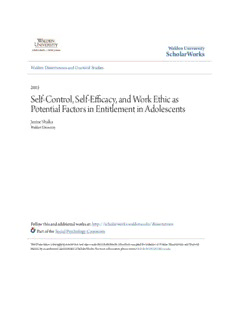
Self-Control, Self-Efficacy, and Work Ethic as Potential Factors in Entitlement in Adolescents PDF
Preview Self-Control, Self-Efficacy, and Work Ethic as Potential Factors in Entitlement in Adolescents
Walden University ScholarWorks Walden Dissertations and Doctoral Studies Walden Dissertations and Doctoral Studies Collection 2015 Self-Control, Self-Efficacy, and Work Ethic as Potential Factors in Entitlement in Adolescents Janine Shalka Walden University Follow this and additional works at:https://scholarworks.waldenu.edu/dissertations Part of theSocial Psychology Commons This Dissertation is brought to you for free and open access by the Walden Dissertations and Doctoral Studies Collection at ScholarWorks. It has been accepted for inclusion in Walden Dissertations and Doctoral Studies by an authorized administrator of ScholarWorks. For more information, please [email protected]. Walden University College of Social and Behavioral Sciences This is to certify that the doctoral dissertation by Janine Shalka has been found to be complete and satisfactory in all respects, and that any and all revisions required by the review committee have been made. Review Committee Dr. Maxwell Rainforth, Committee Chairperson, Psychology Faculty Dr. Vincent Fortunato, Committee Member, Psychology Faculty Dr. Rolande Murray, University Reviewer, Psychology Faculty Chief Academic Officer Eric Riedel, Ph.D. Walden University 2015 Abstract Self-Control, Self-Efficacy, and Work Ethic as Potential Factors in Entitlement in Adolescents by Janine R. Shalka MES, University of Alberta, 2006 BEd, University of Alberta, 1989 BSc, University of Alberta, 1979 Dissertation Submitted in Partial Fulfillment of the Requirements for the Degree of Doctor of Philosophy Psychology Walden University August 2015 Abstract Narcissism has increased in the past 3 decades. Entitlement is a component of narcissism, and substantial research indicates that entitlement is associated with negative behaviors such as aggression, relationship conflict, incivility, and unreasonable expectations in the workplace, learning environments, and relationships. Despite such findings, factors such as self-control, work ethic, and self-efficacy that might explain the variance in entitlement in adolescents has received little investigation. Social cognitive theory indicates that continuous reciprocal relationships exist between personal, behavioral, and environmental factors. The study employed cross-sectional survey research to gather data from 118 students in Grades 10, 11, and 12 in the United States. A multiple regression was used to investigate whether each of self-control, as measured by the Self-Control Scale; work ethic, as measured by the Multidimensional Work Ethic Profile–Short Form; and self-efficacy, as measured by the General Self-Efficacy Scale, explained unique variance in the criterion variable entitlement, as measured by the Psychological Entitlement Scale, and a correlational analysis was used to examine the relationships between the variables. Self-control and work ethic displayed statistically significant negative correlations with entitlement, and each explained unique variance in entitlement. Self-efficacy was not a predictor of entitlement. The findings indicate that parents, teachers, and practitioners should design interventions aimed to increase work ethic and increase self-control to curb entitlement and its negative effects. Self-Control, Self-Efficacy, and Work Ethic as Potential Factors in Entitlement in Adolescents by Janine R. Shalka MES, University of Alberta, 2006 BEd, University of Alberta, 1989 BSc, University of Alberta, 1979 Dissertation Submitted in Partial Fulfillment of the Requirements for the Degree of Doctor of Philosophy Psychology Walden University August 2015 Dedication I dedicate this project to my family—to my four amazing children, and in memory of my husband who began this journey with me but could not be there to the end. Acknowledgments Firstly, I want to express my deepest gratitude to my chair Dr. Maxwell Rainforth. Your wisdom, expertise, and unwavering encouragement made this journey possible. To Dr. Vincent Fortunato, thank you for serving as my committee member and for your valuable advice, meticulous editing, and support. To my children—Tricia, Matthew, Jason, and Drew—I could not have done this without your love and support. For all the times I didn‘t think I could continue and you pushed me, thank you. You are the loves of my life. Table of Contents List of Tables .......................................................................................................................v Chapter 1: Introduction to the Study ....................................................................................1 Introduction ....................................................................................................................1 Background ....................................................................................................................2 Problem Statement .........................................................................................................7 Purpose of the Study ......................................................................................................7 Research Questions and Hypotheses .............................................................................8 Conceptual Framework ..................................................................................................9 Nature of the Study ......................................................................................................11 Definition of Terms......................................................................................................12 Assumptions .................................................................................................................12 Limitations ...................................................................................................................13 Delimitations ................................................................................................................13 Significance of the Study .............................................................................................13 Summary ......................................................................................................................14 Chapter 2: Literature Review .............................................................................................15 Introduction ..................................................................................................................15 Literature Search Strategy............................................................................................16 Narcissism and Entitlement .........................................................................................16 Narcissism ............................................................................................................. 16 Entitlement ............................................................................................................ 24 i Etiological Data ...........................................................................................................27 Research Related to the Hypotheses of the Proposed Study........................................29 Self-control ........................................................................................................... 29 Work Ethic ............................................................................................................ 34 Self-efficacy .......................................................................................................... 36 Conclusion ...................................................................................................................38 Chapter 3: Research Method ..............................................................................................40 Introduction ..................................................................................................................40 Research Design and Approach ...................................................................................40 Setting and Sample ......................................................................................................41 Population and Sample ......................................................................................... 41 Instrumentation ............................................................................................................42 Self-Control Scale ................................................................................................. 43 General Self-Efficacy Scale .................................................................................. 43 Work Ethic Scale .................................................................................................. 44 Psychological Entitlement Scale ........................................................................... 45 Data Collection ............................................................................................................46 Data Analysis ...............................................................................................................47 Threats to Validity .......................................................................................................49 Protection of Human Participants ................................................................................50 Dissemination of Findings ...........................................................................................50 Summary ......................................................................................................................50 ii Chapter 4: Results ..............................................................................................................52 Introduction ..................................................................................................................52 Sample Characteristics .................................................................................................52 Hypothesis Testing.......................................................................................................55 Summary ......................................................................................................................60 Chapter 5: Discussion, Conclusions, and Recommendations ............................................62 Introduction ..................................................................................................................62 Interpretation of Findings ............................................................................................63 Hypotheses 1 ......................................................................................................... 63 Hypothesis 2.......................................................................................................... 64 Hypothesis 3.......................................................................................................... 64 Hypothesis 4.......................................................................................................... 64 Implications..................................................................................................................65 Methodological Implications ................................................................................ 65 Theoretical Implications ....................................................................................... 67 Practical Implications............................................................................................ 71 Limitations of the Study...............................................................................................73 Recommendations for Future Research .......................................................................73 Implications for Positive Social Change ......................................................................77 Conclusion ...................................................................................................................77 References ..........................................................................................................................79 Appendix A: Parent Consent .............................................................................................97 iii
Description: